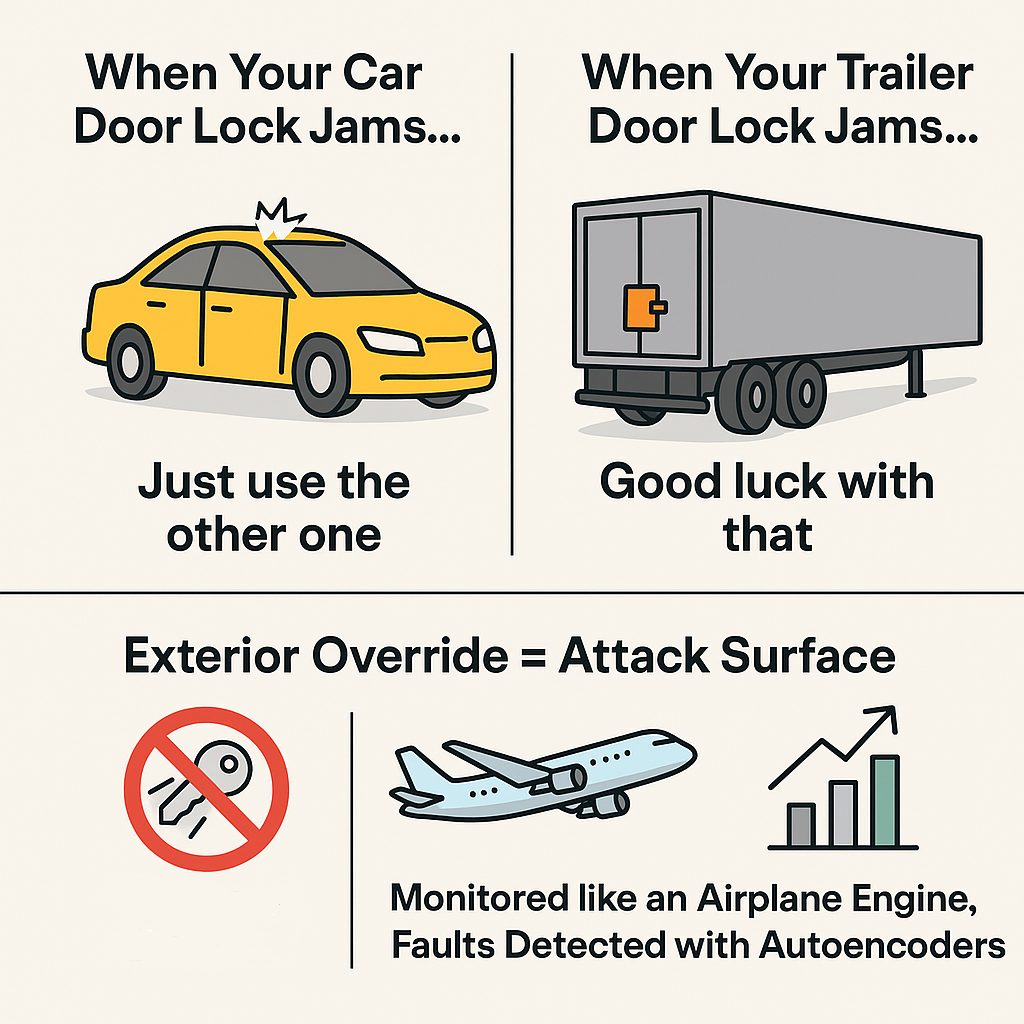Educational Resources
>
When Your Car Door Jams, You Use the Other Door. But What If the Only Door is INSIDE?
When Your Car Door Jams, You Use the Other Door. But What If the Only Door is INSIDE?

Ever had a car door lock jam on you? Frustrating—but luckily, you just shimmy around and pop open another door. Problem solved. But imagine the lock is INSIDE something you absolutely can’t access from the outside—like a high-security cargo trailer carrying valuable freight.
Why would anyone design a lock you can’t open externally? Isn’t that asking for trouble?
Turns out, there’s a smart reason. Interior locks are actually recommended by the Transported Asset Protection Association (TAPA), a global freight security standard, because external access points become targets for thieves and accidental misuse.
In other words, external overrides aren’t just convenience—they’re vulnerabilities. You can’t really have an external override “just in case” and still claim high protection.
That’s why we don’t. Instead, we suggest a high-tech backup for emergencies: a blowtorch and a good story for your insurance company (Just kidding… sort of).
At Level5Fleet, we think freight tech can learn a lot from airplane engines. Those engines are built to fail gracefully—because pulling over mid-air isn’t really an option – despite what TSA might claim.
Airlines don’t wait for something to break. They continuously monitor engines in real time, tracking everything from vibrations to pressure deltas. The goal? Catch anomalies before they become incidents. Maintenance is scheduled proactively—not reactively—based on the tiniest deviations from normal behavior.
We apply the same principle to our interior locks:
- We measure how much force the actuator is using
- We track how many cycles it’s been through
- We look for changes in resistance, timing, and movement profile
Because if the only way in is from the inside, failure isn’t just inconvenient—it’s a liability.
So, what could go wrong? Failures can occur in three ways:
- Software hiccups (like your phone freezing—annoying, but fixable)
- Electronic glitches (think “check engine” light in your car)
- Mechanical jams (think rusted hinge or sticky lock)
To reduce those risks, we run MTBF (Mean Time Between Failures) testing, simulate environmental wear, and apply predictive maintenance models.
But that’s not enough. Because sometimes, failure doesn’t look like failure—until it’s too late.
Enter autoencoders: a type of artificial intelligence designed to spot the unexpected.
What’s an autoencoder? Imagine a security guard who doesn’t memorize faces, but learns how people normally behave. When something seems off—even if it’s never happened before—they flag it.
Autoencoders work the same way: they learn what “normal” sensor behavior looks like, then raise a red flag when something strays too far from baseline.
That’s key, because traditional systems rely on predefined fault signatures. If you’ve never seen a specific failure before, you might miss it entirely. But an autoencoder says: “This pattern doesn’t feel right”—and that gives you time to act.
Think of it as keeping your car door from jamming in the first place—no awkward climbing required.
Security without reliability is theatre. Reliability without security is pointless.
At Admiral, we bridge that gap. Curious to learn more? Drop us a note—we’d love to show you behind the scenes.
The Future of Tractor-Trailer Security